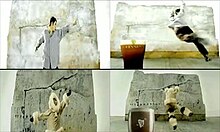- Bushmills Original – Irish whiskey blend sometimes called White Bush or Bushmills White Label. The grain whiskey is matured in American oak casks.
- Black Bush – A blend with a significantly greater proportion of malt whiskey than the white label. It features malt whiskey aged in casks previously used for Spanish Oloroso sherry.
- Red Bush – Like the Black Bush, this is a blend with a higher proportion of malt whiskey than the standard bottling, but in contrast the malt whiskey has been matured in ex-bourbon casks.
- Bushmills 10 year single malt – Combines malt whiskeys aged at least 10 years in American bourbon or Oloroso sherry casks.
- Bushmills Distillery Reserve 12 year single malt – exclusively available at the Old Bushmills Distillery, this 12 year aged single malt is matured in oak casks for a rich, complex flavour with notes of sherry, dark chocolate and spices.
- Bushmills 16 year single malt – Malt whiskeys aged at least 16 years in American bourbon barrels or Spanish Oloroso sherry butts are mixed together before finishing in Port pipes for a few months.
- Bushmills 21 year single malt – A limited number of 21 year bottles are made each year. After 19 years, bourbon-barrel-aged and sherry-cask-aged malt whiskeys are combined, which is followed by two years of finishing in Madeira drums.
- Bushmills 1608: Originally released as a special 400th Anniversary whiskey; since 2009 it will be available only in the Whiskey Shop at the distillery and at duty-free shops.
-

 Old Bushmills Irish Whiskey advert- depicting the Cheshire Hunt .Officially the worlds oldest whiskey distillery- when in 1608 King James I granted Sir Thomas Phillips,landowner and Governor of Co Antrim,Ireland - a licence to distill.It was in 1784 when Mr Hugh Anderson registered the Old Bushmills Distillery and the Pot Still became its registered trademark, which is still a mark of genuine distinction to this day. 50cm x 65cm Belfast The Bushmills area has a long tradition with distillation. According to one story, as far back as 1276, an early settler called Sir Robert Savage of Ards, before defeating the Irish in battle, fortified his troops with "a mighty drop of acqua vitae". In 1608, a licence was granted to Sir Thomas Phillips (Irish adventurer) by King James I to distil whiskey. The Bushmills Old Distillery Company itself was not established until 1784 by Hugh Anderson. Bushmills suffered many lean years with numerous periods of closure with no record of the distillery being in operation in the official records both in 1802 and in 1822. In 1860 a Belfast spirit merchant named Jame McColgan and Patrick Corrigan bought the distillery; in 1880 they formed a limited company. In 1885, the original Bushmills buildings were destroyed by fire but the distillery was swiftly rebuilt. In 1890, a steamship owned and operated by the distillery, SS Bushmills, made its maiden voyage across the Atlantic to deliver Bushmills whiskey to America. It called at Philadelphiaand New York City before heading on to Singapore, Hong Kong, Shanghai and Yokohama.In the early 20th century, the U.S. was a very important market for Bushmills (and other Irish Whiskey producers). American Prohibition in 1920 came as a large blow to the Irish Whiskey industry, but Bushmills managed to survive. Wilson Boyd, Bushmills' director at the time, predicted the end of prohibition and had large stores of whiskey ready to export. After the Second World War, the distillery was bought by Isaac Wolfson, and, in 1972, it was taken over by Irish Distillers, meaning that Irish Distillers controlled the production of all Irish whiskey at the time. In June 1988, Irish Distillers was bought by French liquor group Pernod Ricard.In June 2005, the distillery was bought by Diageo for £200 million. Diageo have also announced a large advertising campaign in order to regain a market share for Bushmills.In May 2008, the Bank of Ireland issued a new series of sterling banknotes in Northern Ireland which all feature an illustration of the Old Bushmills Distillery on the obverse side, replacing the previous notes series which depicted Queen's University of Belfast. In November 2014 it was announced that Diageo had traded the Bushmills brand with Jose Cuervo in exchange for the 50% of the Don Julio brand of tequila that Diageo did not already own.
Old Bushmills Irish Whiskey advert- depicting the Cheshire Hunt .Officially the worlds oldest whiskey distillery- when in 1608 King James I granted Sir Thomas Phillips,landowner and Governor of Co Antrim,Ireland - a licence to distill.It was in 1784 when Mr Hugh Anderson registered the Old Bushmills Distillery and the Pot Still became its registered trademark, which is still a mark of genuine distinction to this day. 50cm x 65cm Belfast The Bushmills area has a long tradition with distillation. According to one story, as far back as 1276, an early settler called Sir Robert Savage of Ards, before defeating the Irish in battle, fortified his troops with "a mighty drop of acqua vitae". In 1608, a licence was granted to Sir Thomas Phillips (Irish adventurer) by King James I to distil whiskey. The Bushmills Old Distillery Company itself was not established until 1784 by Hugh Anderson. Bushmills suffered many lean years with numerous periods of closure with no record of the distillery being in operation in the official records both in 1802 and in 1822. In 1860 a Belfast spirit merchant named Jame McColgan and Patrick Corrigan bought the distillery; in 1880 they formed a limited company. In 1885, the original Bushmills buildings were destroyed by fire but the distillery was swiftly rebuilt. In 1890, a steamship owned and operated by the distillery, SS Bushmills, made its maiden voyage across the Atlantic to deliver Bushmills whiskey to America. It called at Philadelphiaand New York City before heading on to Singapore, Hong Kong, Shanghai and Yokohama.In the early 20th century, the U.S. was a very important market for Bushmills (and other Irish Whiskey producers). American Prohibition in 1920 came as a large blow to the Irish Whiskey industry, but Bushmills managed to survive. Wilson Boyd, Bushmills' director at the time, predicted the end of prohibition and had large stores of whiskey ready to export. After the Second World War, the distillery was bought by Isaac Wolfson, and, in 1972, it was taken over by Irish Distillers, meaning that Irish Distillers controlled the production of all Irish whiskey at the time. In June 1988, Irish Distillers was bought by French liquor group Pernod Ricard.In June 2005, the distillery was bought by Diageo for £200 million. Diageo have also announced a large advertising campaign in order to regain a market share for Bushmills.In May 2008, the Bank of Ireland issued a new series of sterling banknotes in Northern Ireland which all feature an illustration of the Old Bushmills Distillery on the obverse side, replacing the previous notes series which depicted Queen's University of Belfast. In November 2014 it was announced that Diageo had traded the Bushmills brand with Jose Cuervo in exchange for the 50% of the Don Julio brand of tequila that Diageo did not already own. -

 34cm x 22cmThis Flying Column operated across the West Mayo area during the War of Independence. The photograph was taken shortly after the Carrowkennedy ambush on a RIC Barracks; the men are displaying the captured weapons. On the 2nd June 1921 the West Mayo Flying Column ambushed British soldiers on the Westport to Leenane road. After the ambush they went on the run. While near Laherdane in the vicinity of Neiphin Mountain they were visited by Jack Leonard. Leonard was a photographer and a cousin of Michael Kilroy, who was the Officer in Command of the brigade and took the only photograph of the Flying Column that exists.
34cm x 22cmThis Flying Column operated across the West Mayo area during the War of Independence. The photograph was taken shortly after the Carrowkennedy ambush on a RIC Barracks; the men are displaying the captured weapons. On the 2nd June 1921 the West Mayo Flying Column ambushed British soldiers on the Westport to Leenane road. After the ambush they went on the run. While near Laherdane in the vicinity of Neiphin Mountain they were visited by Jack Leonard. Leonard was a photographer and a cousin of Michael Kilroy, who was the Officer in Command of the brigade and took the only photograph of the Flying Column that exists.
-
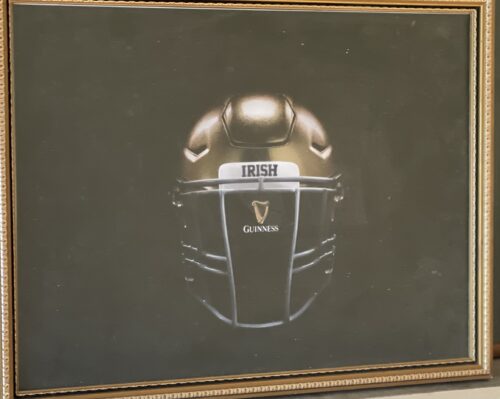
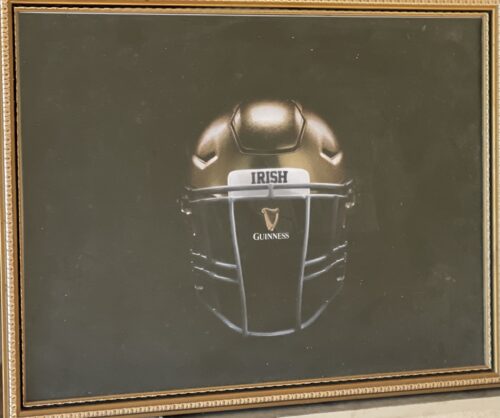 The television commercial created by the famous brewing company will leave you with a smile on your face and maybe a craving for a pint of the black stuff! Former Fighting Irish quarterback Joe Montana features in this Guinness US commercial from 2021, while a cover of the catchy 1999 song "Praise You" plays in the background. On a trip with my family to Ireland, I fell in love with Guinness. A perfect pint is lighter and more delicious than I ever imagined," Montana previously said in an interview. Guinness US is currently running a seven-year collaboration with Notre Dame Fighting Irish, uniting two Irish institutions, and raising a Guinness toast to honor the Irish faithful – whether you're Irish by blood or in spirit. The brewing company is also the official beer of Notre Dame Fighting Irish and fans can enjoy this weekend game and relive their favorite football memories with the special edition Notre Dame 8-packs of Guinness Draught cans, which can be found across select U.S. markets, including Indiana, New York, Chicago and Boston.
The television commercial created by the famous brewing company will leave you with a smile on your face and maybe a craving for a pint of the black stuff! Former Fighting Irish quarterback Joe Montana features in this Guinness US commercial from 2021, while a cover of the catchy 1999 song "Praise You" plays in the background. On a trip with my family to Ireland, I fell in love with Guinness. A perfect pint is lighter and more delicious than I ever imagined," Montana previously said in an interview. Guinness US is currently running a seven-year collaboration with Notre Dame Fighting Irish, uniting two Irish institutions, and raising a Guinness toast to honor the Irish faithful – whether you're Irish by blood or in spirit. The brewing company is also the official beer of Notre Dame Fighting Irish and fans can enjoy this weekend game and relive their favorite football memories with the special edition Notre Dame 8-packs of Guinness Draught cans, which can be found across select U.S. markets, including Indiana, New York, Chicago and Boston. -
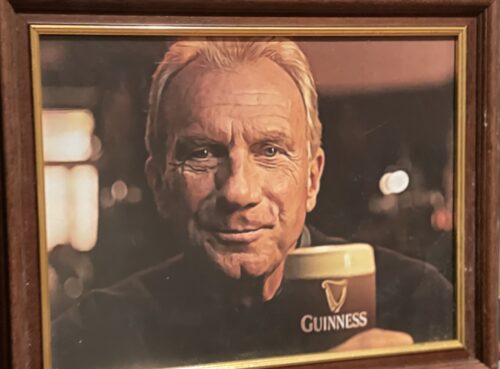
 The television commercial created by the famous brewing company will leave you with a smile on your face and maybe a craving for a pint of the black stuff! Former Fighting Irish quarterback Joe Montana features in this Guinness US commercial from 2021, while a cover of the catchy 1999 song "Praise You" plays in the background. On a trip with my family to Ireland, I fell in love with Guinness. A perfect pint is lighter and more delicious than I ever imagined," Montana previously said in an interview. Guinness US is currently running a seven-year collaboration with Notre Dame Fighting Irish, uniting two Irish institutions, and raising a Guinness toast to honor the Irish faithful – whether you're Irish by blood or in spirit. The brewing company is also the official beer of Notre Dame Fighting Irish and fans can enjoy this weekend game and relive their favorite football memories with the special edition Notre Dame 8-packs of Guinness Draught cans, which can be found across select U.S. markets, including Indiana, New York, Chicago and Boston.
The television commercial created by the famous brewing company will leave you with a smile on your face and maybe a craving for a pint of the black stuff! Former Fighting Irish quarterback Joe Montana features in this Guinness US commercial from 2021, while a cover of the catchy 1999 song "Praise You" plays in the background. On a trip with my family to Ireland, I fell in love with Guinness. A perfect pint is lighter and more delicious than I ever imagined," Montana previously said in an interview. Guinness US is currently running a seven-year collaboration with Notre Dame Fighting Irish, uniting two Irish institutions, and raising a Guinness toast to honor the Irish faithful – whether you're Irish by blood or in spirit. The brewing company is also the official beer of Notre Dame Fighting Irish and fans can enjoy this weekend game and relive their favorite football memories with the special edition Notre Dame 8-packs of Guinness Draught cans, which can be found across select U.S. markets, including Indiana, New York, Chicago and Boston. -

 32cm x 28cm Originating from an pub in Co Kerry -this innuendo laden election poster will catch the eye in any bar ! Richard Nixon’s mother Hannah was descended from the Milhous family, Irish Quakers from Timahoe, Kildare while the first Nixon to arrive in the US, James, left Ireland in 1731. President Nixon visited the small town in October 1970 during a state visit to Ireland. He is the only US president to date to resign from office following his involvement in the Watergate scandal.
32cm x 28cm Originating from an pub in Co Kerry -this innuendo laden election poster will catch the eye in any bar ! Richard Nixon’s mother Hannah was descended from the Milhous family, Irish Quakers from Timahoe, Kildare while the first Nixon to arrive in the US, James, left Ireland in 1731. President Nixon visited the small town in October 1970 during a state visit to Ireland. He is the only US president to date to resign from office following his involvement in the Watergate scandal. -
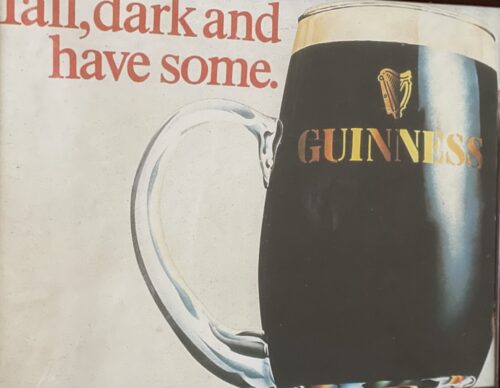
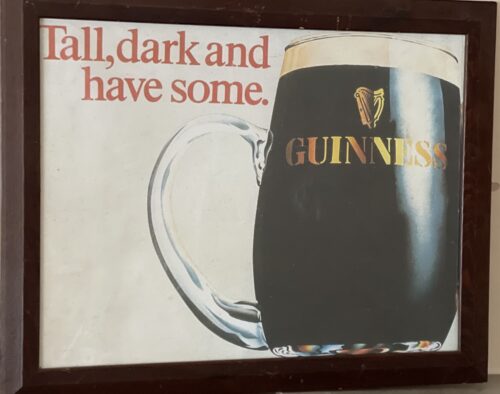 50cm x 65cm Imagination is something Guinness Advertising has never been short of… From John Gilroy’s hapless zookeeper and his menagerie of creatures to a Polynesian surfer and a herd of white horses; from messages in bottles setting sail across the ocean to a single, heart-stoppingly enormous wave. Guinness have been carving out their own creative path for almost a century with decades of extraordinary and enduring print, TV and digital campaigns to their name, and hopefully they will continue to push boundaries to tell stories to the world. Here’s to original thinking !
50cm x 65cm Imagination is something Guinness Advertising has never been short of… From John Gilroy’s hapless zookeeper and his menagerie of creatures to a Polynesian surfer and a herd of white horses; from messages in bottles setting sail across the ocean to a single, heart-stoppingly enormous wave. Guinness have been carving out their own creative path for almost a century with decades of extraordinary and enduring print, TV and digital campaigns to their name, and hopefully they will continue to push boundaries to tell stories to the world. Here’s to original thinking ! -
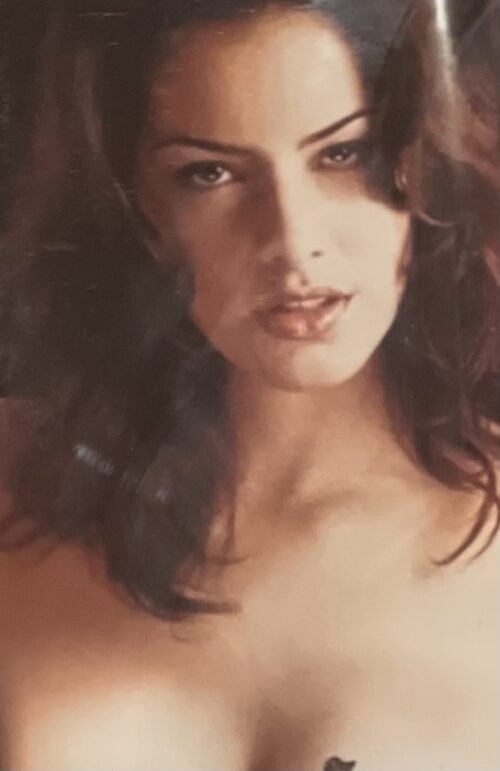
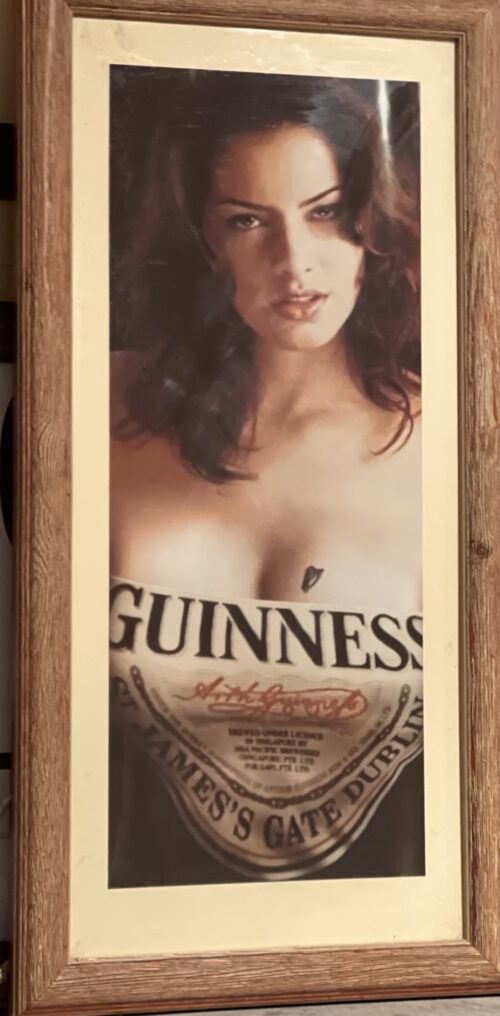 74cm x 38cm Imagination is something Guinness Advertising has never been short of… From John Gilroy’s hapless zookeeper and his menagerie of creatures to a Polynesian surfer and a herd of white horses; from messages in bottles setting sail across the ocean to a single, heart-stoppingly enormous wave. Guinness have been carving out their own creative path for almost a century with decades of extraordinary and enduring print, TV and digital campaigns to their name, and hopefully they will continue to push boundaries to tell stories to the world. Here’s to original thinking !
74cm x 38cm Imagination is something Guinness Advertising has never been short of… From John Gilroy’s hapless zookeeper and his menagerie of creatures to a Polynesian surfer and a herd of white horses; from messages in bottles setting sail across the ocean to a single, heart-stoppingly enormous wave. Guinness have been carving out their own creative path for almost a century with decades of extraordinary and enduring print, TV and digital campaigns to their name, and hopefully they will continue to push boundaries to tell stories to the world. Here’s to original thinking ! -

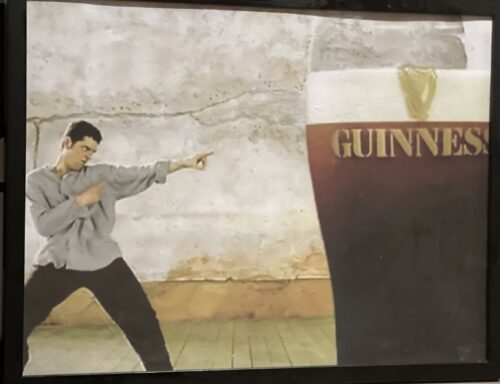 45cm x 60cm Anticipation is an Irish advertisement launched by Guinness plc in 1994 to promote Guinness-brand draught stout. The advert, which appeared in print, posters, and cinema and television spots, was conceived by Irish advertising agency Arks, and starred relatively unknown Irish actor Joe McKinney as the 'Dancing Man' and Gordon Winter as the barman. It was the final part of the "Guinness Time" advertising campaign, which had been running in Ireland since the late 1980s. The advert was credited with increasing Guinness' sales, market share and brand awareness figures. However, controversy arose following claims of plagiarism raised by British director Mehdi Norowzian, who launched an unsuccessful lawsuit in 1998 seeking remuneration for the use of techniques and style from his 1992 short film Joy.
45cm x 60cm Anticipation is an Irish advertisement launched by Guinness plc in 1994 to promote Guinness-brand draught stout. The advert, which appeared in print, posters, and cinema and television spots, was conceived by Irish advertising agency Arks, and starred relatively unknown Irish actor Joe McKinney as the 'Dancing Man' and Gordon Winter as the barman. It was the final part of the "Guinness Time" advertising campaign, which had been running in Ireland since the late 1980s. The advert was credited with increasing Guinness' sales, market share and brand awareness figures. However, controversy arose following claims of plagiarism raised by British director Mehdi Norowzian, who launched an unsuccessful lawsuit in 1998 seeking remuneration for the use of techniques and style from his 1992 short film Joy.Sequence
The low-budget ad featured only two characters: a patron of a pub and the barman serving him. The patron (McKinney) orders a pint of Guinness stout and, while waiting for the pint to be poured, carries out a series of quirky dancing movements with the settling pint in the foreground, to the amusement of the barman (Winter). The piece ends with the patron taking his first sip of the freshly poured pint overlaid by the Guinness advertising slogan "No time like Guinness Time". The advert is set to Guaglione by Pérez Prado, and makes heavy use of jump cutting from a static camera to allow the dancer to make a series of movements that could not be achieved in reality.Reception
The distinctive jump cut editing techniques of Anticipation won the commercial critical acclaim and several awards from within the advertising industry, including the 1995 Institute of Creative Advertising & Design craft award for editing as well as a Gold Medal for editing and a Golden Shark award at the Kinsale International Advertising Festival. The success of the campaign led Guinness to re-broadcast it in the United Kingdom in 1995, as a transition between the campaign "The Man With the Guinness"/"Pure Genius", which had just concluded with Chain, and its new "Black and White" campaign, still in development.Though Chain was to be the last in the Pure Genius campaign, Anticipationwas tagged with the Pure Genius slogan in the UK instead of There's No Time Like Guinness Time. As a result of its featuring in the spot, Pérez Prado's Guaglione reached the Number 1 spot in the Irish music charts,and Number 2 in the British Top 40.Lawsuit
In 1992, British director Mehdi Norowzian submitted a show reel containing a number of short examples of his work to several prospective employers, including the Irish advertising agency Arks Ltd., in the hopes of being taken on to direct one or more of their commercials. Included on the reel was a short piece entitled Joy, which was shot using a static camera on a London rooftop and comprised a jump cut sequence of a man performing an extended dance of exuberance against a plain canvas background. Arks Ltd. were contracted by Guinness to produce an advertisement to run in Ireland. Among the ideas proposed was one based on a scene from the cinematic version of Roddy Doyle's novel, The Snapper, where a man rushes into a pub to celebrate the birth of his grandson with a pint of Guinness. The artistic director at Arks, thinking of possible ways to build on the concept, recalled Norowzian's submitted reel and came up with a script and storyboard based on Joy to present to Guinness. The idea was accepted, and Arks approached Norowzian to direct the commercial. Norowzian refused, as he was unwilling to simply "commercialise" an old idea, and wanted to create something new. The agency then took on Richie Smyth as director, urging him to create something "with an atmosphere broadly similar to that portrayed in Joy". Feeling that the original storyboard was too close to Joy, a new one was prepared. The result was Anticipation. Following the broadcast of the television spot in 1994, Norowzian lodged a complaint and ultimately a lawsuit against Arks Ltd. and Guinness, claiming that Anticipation breached his copyrights and accusing the agency of passing off. The plaintiff's claim for copyright infringement were based on a passage in the Copyright, Designs and Patents Act 1988defining a dramatic work as including "recordings of a work of dance or mime", and that Anticipation was, or included, a copy of a substantial part of Joy. The case reached the High Court in 1997, where the claim of passing off was dropped. On 17 July 1998, Justice Rattee rendered his judgment that the jump cutting techniques used in Joy produced something qualitatively different from a recording of a dance or mime routine and that, as such, Joy was not in itself a dramatic work. It was therefore defined as an entrepreneurial work, a status which confers protection over only the physical recording of a work rather than the work itself. He also ruled that Anticipation did not reproduce either the whole or part of Joy. The decision was appealed, but while the Court of Appeal unanimously held that the content of a film (including the use of film and editing techniques) could enjoy copyright protection as a dramatic work, the presiding Justices ruled that Anticipation did not significantly copy any portion of Joy and dismissed the case. Ultimately, Norowzian was ordered to pay £200,000 in legal costs.As a result of the case, the Institute of Contemporary Arts called for reform of copyright law in the United Kingdom.Legacy
Actor Joe McKinney spent 1994–6 making personal appearances around Europe publicising Guinness. The lifestyle became too hectic and he gave up alcohol in 1997.He found it difficult to secure other roles due to typecasting as "the Guinness man", spending time in the US where the ad had not been broadcast. As one of the most recognisable Guinness advertisements of the 1990s, Anticipation has been mimicked or parodied in a number of more recent Guinness campaigns, including the Irish Waiting spot in 2004 promoting cans of Guinness draught beer,and director JJ Keith's British Eskimo commercial, which was part of an extended campaign promoting Guinness Extra Cold in summer 2004 and 2005. In March 2009, Guinness announced that Anticipation would be aired again as part of a "Classic Ads" campaign to mark the brewery's 250th anniversary. Imagination is something Guinness Advertising has never been short of… From John Gilroy’s hapless zookeeper and his menagerie of creatures to a Polynesian surfer and a herd of white horses; from messages in bottles setting sail across the ocean to a single, heart-stoppingly enormous wave. Guinness have been carving out their own creative path for almost a century with decades of extraordinary and enduring print, TV and digital campaigns to their name, and hopefully they will continue to push boundaries to tell stories to the world. Here’s to original thinking ! -
Out of stock

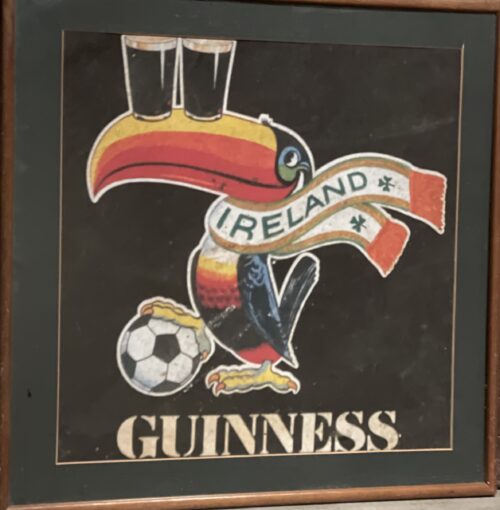 51cm x 51cm Imagination is something Guinness Advertising has never been short of… From John Gilroy’s hapless zookeeper and his menagerie of creatures to a Polynesian surfer and a herd of white horses; from messages in bottles setting sail across the ocean to a single, heart-stoppingly enormous wave. Guinness have been carving out their own creative path for almost a century with decades of extraordinary and enduring print, TV and digital campaigns to their name, and hopefully they will continue to push boundaries to tell stories to the world. Here’s to original thinking !
51cm x 51cm Imagination is something Guinness Advertising has never been short of… From John Gilroy’s hapless zookeeper and his menagerie of creatures to a Polynesian surfer and a herd of white horses; from messages in bottles setting sail across the ocean to a single, heart-stoppingly enormous wave. Guinness have been carving out their own creative path for almost a century with decades of extraordinary and enduring print, TV and digital campaigns to their name, and hopefully they will continue to push boundaries to tell stories to the world. Here’s to original thinking ! -

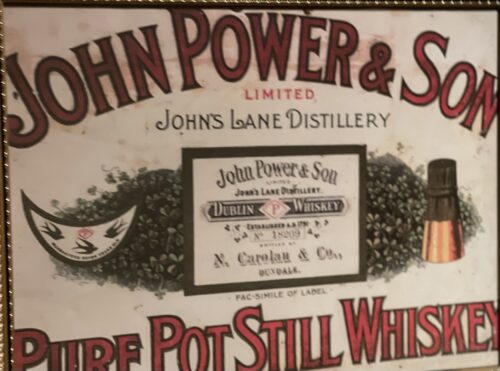 44cm x 33cm Limerick In 1791 James Power, an innkeeper from Dublin, established a small distillery at his public house at 109 Thomas St., Dublin. The distillery, which had an output of about 6,000 gallons in its first year of operation, initially traded as James Power and Son, but by 1822 had become John Power & Son, and had moved to a new premises at John's Lane, a side street off Thomas Street. At the time the distillery had three pot stills, though only one, a 500-gallon still is thought to have been in use. Following reform of the distilling laws in 1823, the distillery expanded rapidly. In 1827, production was reported at 160,270 gallons,and by 1833 had grown to 300,000 gallons per annum. As the distillery grew, so too did the stature of the family. In 1841, John Power, grandson of the founder was awarded a baronet, a hereditary title. In 1855, his son Sir James Power, laid the foundation stone for the O'Connell Monument, and in 1859 became High Sheriff of Dublin. In 1871, the distillery was expanded and rebuilt in the Victorian style, becoming one of the most impressive sights in Dublin.After expansion, output at the distillery rose to 700,000 gallons per annum, and by the 1880s, had reached about 900,000 gallons per annum, at which point the distillery covered over six acres of central Dublin, and had a staff of about 300 people.During this period, when the Dublin whiskey distilleries were amongst the largest in the world, the family run firms of John Powers, along with John Jameson, William Jameson, and George Roe, (collectively known as the "Big Four") came to dominate the Irish distilling landscape, introducing several innovations. In 1886, John Power & Son began bottling their own whiskey, rather than following the practice customary at the time, of selling whiskey directly to merchants and bonders who would bottle it themselves. They were the first Dublin distillery to do so, and one of the first in the world.A gold label adorned each bottle and it was from these that the whiskey got the name Powers Gold Label. When Alfred Barnard, the British historian visited John's Lane in the late 1880s, he noted the elegance and cleanliness of the buildings, and the modernity of the distillery, describing it as "about as complete a work as it is possible to find anywhere". At the time of his visit, the distillery was home to five pot stills, two of which with capacities of 25,000 gallons, were amongst the largest ever built.In addition, Barnard was high in his praise for Powers whiskey, noting:"The old make, which we drank with our luncheon was delicious and finer than anything we had hitherto tasted.It was as perfect in flavour, and as pronounced in the ancient aroma of Irish Whiskey so dear to to the hearts of connoisseurs,as one could possibly desire and we found a small flask of it very useful afterwards on our travels." The last member of the family to sit on the board was Sir Thomas Talbot Power,who died in 1930,and with him the Power's Baronetcy. However, ownership remained in the family until 1966, and several descendants of his sisters remained at work with the company until recent times. In 1961, a Coffey still was installed in John's Lane Distillery, allowing the production of vodka and gin, in addition to the testing of grain whiskey for use in blended whiskey. This was a notable departure for the firm, as for many years the big Dublin distilling dynasties had shunned the use of Coffey stills, questioning if their output, grain whiskey could even be termed whiskey. However, with many of the Irish distilleries having closed in the early 20th century in part due to their failure to embrace a change in consumer preference towards blended whiskey, Powers were instrumental in convincing the remaining Irish distilleries to reconsider their stance on blended whiskey. In 1966, with the Irish whiskey industry still struggling following Prohibition in the United States, the Anglo-Irish Trade War and the rise of competition from Scotch whiskey, John Powers & Son joined forces with the only other remaining distillers in the Irish Republic, the Cork Distilleries Company and their Dublin rivals John Jameson & Son, to form Irish Distillers. Soon after, in a bold move, Irish Distillers decided to close all of their existing distilleries, and to consolidate production at a new purpose-built facility in Midleton (the New Midleton Distillery) alongside their existing Old Midleton Distillery. The new distillery opened in 1975, and a year later, production ceased at John's Lane Distillery and began anew in Cork, with Powers Gold Label and many other Irish whiskeys reformulated from single pot stills whiskeys to blends. In 1989, Irish Distillers itself became a subsidiary of Pernod-Ricard following a friendly takeover.Since the closure of the John's Lane distillery, many of the distillery buildings were demolished. However, some of the buildings have been incorporated into the National College of Art and Design, and are now protected structures. In addition, three of the distillery's pot stills were saved and now located in the college's Red Square.
44cm x 33cm Limerick In 1791 James Power, an innkeeper from Dublin, established a small distillery at his public house at 109 Thomas St., Dublin. The distillery, which had an output of about 6,000 gallons in its first year of operation, initially traded as James Power and Son, but by 1822 had become John Power & Son, and had moved to a new premises at John's Lane, a side street off Thomas Street. At the time the distillery had three pot stills, though only one, a 500-gallon still is thought to have been in use. Following reform of the distilling laws in 1823, the distillery expanded rapidly. In 1827, production was reported at 160,270 gallons,and by 1833 had grown to 300,000 gallons per annum. As the distillery grew, so too did the stature of the family. In 1841, John Power, grandson of the founder was awarded a baronet, a hereditary title. In 1855, his son Sir James Power, laid the foundation stone for the O'Connell Monument, and in 1859 became High Sheriff of Dublin. In 1871, the distillery was expanded and rebuilt in the Victorian style, becoming one of the most impressive sights in Dublin.After expansion, output at the distillery rose to 700,000 gallons per annum, and by the 1880s, had reached about 900,000 gallons per annum, at which point the distillery covered over six acres of central Dublin, and had a staff of about 300 people.During this period, when the Dublin whiskey distilleries were amongst the largest in the world, the family run firms of John Powers, along with John Jameson, William Jameson, and George Roe, (collectively known as the "Big Four") came to dominate the Irish distilling landscape, introducing several innovations. In 1886, John Power & Son began bottling their own whiskey, rather than following the practice customary at the time, of selling whiskey directly to merchants and bonders who would bottle it themselves. They were the first Dublin distillery to do so, and one of the first in the world.A gold label adorned each bottle and it was from these that the whiskey got the name Powers Gold Label. When Alfred Barnard, the British historian visited John's Lane in the late 1880s, he noted the elegance and cleanliness of the buildings, and the modernity of the distillery, describing it as "about as complete a work as it is possible to find anywhere". At the time of his visit, the distillery was home to five pot stills, two of which with capacities of 25,000 gallons, were amongst the largest ever built.In addition, Barnard was high in his praise for Powers whiskey, noting:"The old make, which we drank with our luncheon was delicious and finer than anything we had hitherto tasted.It was as perfect in flavour, and as pronounced in the ancient aroma of Irish Whiskey so dear to to the hearts of connoisseurs,as one could possibly desire and we found a small flask of it very useful afterwards on our travels." The last member of the family to sit on the board was Sir Thomas Talbot Power,who died in 1930,and with him the Power's Baronetcy. However, ownership remained in the family until 1966, and several descendants of his sisters remained at work with the company until recent times. In 1961, a Coffey still was installed in John's Lane Distillery, allowing the production of vodka and gin, in addition to the testing of grain whiskey for use in blended whiskey. This was a notable departure for the firm, as for many years the big Dublin distilling dynasties had shunned the use of Coffey stills, questioning if their output, grain whiskey could even be termed whiskey. However, with many of the Irish distilleries having closed in the early 20th century in part due to their failure to embrace a change in consumer preference towards blended whiskey, Powers were instrumental in convincing the remaining Irish distilleries to reconsider their stance on blended whiskey. In 1966, with the Irish whiskey industry still struggling following Prohibition in the United States, the Anglo-Irish Trade War and the rise of competition from Scotch whiskey, John Powers & Son joined forces with the only other remaining distillers in the Irish Republic, the Cork Distilleries Company and their Dublin rivals John Jameson & Son, to form Irish Distillers. Soon after, in a bold move, Irish Distillers decided to close all of their existing distilleries, and to consolidate production at a new purpose-built facility in Midleton (the New Midleton Distillery) alongside their existing Old Midleton Distillery. The new distillery opened in 1975, and a year later, production ceased at John's Lane Distillery and began anew in Cork, with Powers Gold Label and many other Irish whiskeys reformulated from single pot stills whiskeys to blends. In 1989, Irish Distillers itself became a subsidiary of Pernod-Ricard following a friendly takeover.Since the closure of the John's Lane distillery, many of the distillery buildings were demolished. However, some of the buildings have been incorporated into the National College of Art and Design, and are now protected structures. In addition, three of the distillery's pot stills were saved and now located in the college's Red Square. The Still House at John's Lane Distillery, as it looked when Alfred Barnard visited in the 1800s.
The Still House at John's Lane Distillery, as it looked when Alfred Barnard visited in the 1800s.
-

 44cm x 33cm Rare post WW2 Fianna Fáil election manifesto poster -Step Together-Fianna Fail.The Republican Party was founded in 1926 by Eamon De Valera and his supporters after they split from Sinn Fein on the issue of abstentionism, in the aftermath of the Irish Civil War. Eamon de Valera, first registered as George de Valero; changed some time before 1901 to Edward de Valera;14 October 1882 – 29 August 1975) was a prominent statesman and political leader in 20th-century Ireland. His political career spanned over half a century, from 1917 to 1973; he served several terms as head of government and head of state. He also led the introduction of the Constitution of Ireland. Prior to de Valera's political career, he was a Commandant at Boland's Mill during the 1916 Easter Rising, an Irish revolution that would eventually contribute to Irish independence. He was arrested, sentenced to death but released for a variety of reasons, including the public response to the British execution of Rising leaders. He returned to Ireland after being jailed in England and became one of the leading political figures of the War of Independence. After the signing of the Anglo-Irish Treaty, de Valera served as the political leader of Anti-Treaty Sinn Fein until 1926, when he, along with many supporters, left the party to set up Fianna Fáil, a new political party which abandoned the policy of abstentionism from Dáil Éireann. From there, de Valera would go on to be at the forefront of Irish politics until the turn of the 1960s. He took over as President of the Executive Councilfrom W. T. Cosgrave and later Taoiseach, with the passing of Bunreacht Na hEireann (Irish constitution) in 1937. He would serve as Taoiseach on 3 occasions; from 1937 to 1948, from 1951 to 1954 and finally from 1957 to 1959. He remains the longest serving Taoiseach by total days served in the post. He resigned in 1959 upon his election as President of Ireland. By then, he had been Leader of Fianna Fáil for 33 years, and he, along with older founding members, began to take a less prominent role relative to newer ministers such as Jack Lynch, Charles Haughey and Neil Blaney. He would serve as President from 1959 to 1973, two full terms in office. De Valera's political beliefs evolved from militant Irish republicanism to strong social, cultural and economic conservatism.He has been characterised by a stern, unbending, devious demeanor. His roles in the Civil War have also portrayed him as a divisive figure in Irish history. Biographer Tim Pat Coogan sees his time in power as being characterised by economic and cultural stagnation, while Diarmaid Ferriter argues that the stereotype of de Valera as an austere, cold and even backward figure was largely manufactured in the 1960s and is misguided. Origins: Co Clare Dimensions : 50cm x 40cm
44cm x 33cm Rare post WW2 Fianna Fáil election manifesto poster -Step Together-Fianna Fail.The Republican Party was founded in 1926 by Eamon De Valera and his supporters after they split from Sinn Fein on the issue of abstentionism, in the aftermath of the Irish Civil War. Eamon de Valera, first registered as George de Valero; changed some time before 1901 to Edward de Valera;14 October 1882 – 29 August 1975) was a prominent statesman and political leader in 20th-century Ireland. His political career spanned over half a century, from 1917 to 1973; he served several terms as head of government and head of state. He also led the introduction of the Constitution of Ireland. Prior to de Valera's political career, he was a Commandant at Boland's Mill during the 1916 Easter Rising, an Irish revolution that would eventually contribute to Irish independence. He was arrested, sentenced to death but released for a variety of reasons, including the public response to the British execution of Rising leaders. He returned to Ireland after being jailed in England and became one of the leading political figures of the War of Independence. After the signing of the Anglo-Irish Treaty, de Valera served as the political leader of Anti-Treaty Sinn Fein until 1926, when he, along with many supporters, left the party to set up Fianna Fáil, a new political party which abandoned the policy of abstentionism from Dáil Éireann. From there, de Valera would go on to be at the forefront of Irish politics until the turn of the 1960s. He took over as President of the Executive Councilfrom W. T. Cosgrave and later Taoiseach, with the passing of Bunreacht Na hEireann (Irish constitution) in 1937. He would serve as Taoiseach on 3 occasions; from 1937 to 1948, from 1951 to 1954 and finally from 1957 to 1959. He remains the longest serving Taoiseach by total days served in the post. He resigned in 1959 upon his election as President of Ireland. By then, he had been Leader of Fianna Fáil for 33 years, and he, along with older founding members, began to take a less prominent role relative to newer ministers such as Jack Lynch, Charles Haughey and Neil Blaney. He would serve as President from 1959 to 1973, two full terms in office. De Valera's political beliefs evolved from militant Irish republicanism to strong social, cultural and economic conservatism.He has been characterised by a stern, unbending, devious demeanor. His roles in the Civil War have also portrayed him as a divisive figure in Irish history. Biographer Tim Pat Coogan sees his time in power as being characterised by economic and cultural stagnation, while Diarmaid Ferriter argues that the stereotype of de Valera as an austere, cold and even backward figure was largely manufactured in the 1960s and is misguided. Origins: Co Clare Dimensions : 50cm x 40cm -

 50cm x 60cm The Dubliners were quite simply one of the most famous Irish folk bands of all time.Founded in 1962,they enjoyed a 50 year career with the success of the band centred on their two lead singers,Luke Kelly and Ronnie Drew.They garnered massive international acclaim with their lively Irish folk songs,traditional street ballads and instrumentals eventually crossing over to mainstream culture by appearing on Top of the Pops in 1967 with "Seven Drunken Nights" which sold over 250000 singles in the UK alone.Later a number of collaborations with the Pogues saw them enter the UK singles charts again on another 2 occasions.Instrumental in popularising Irish folk music abroad ,they influenced many generations of Irish bands and covers of Irish ballads such as Raglan Road and the Auld Triangle by Luke Kelly and Ronnie Drew tend to be regarded as definitive versions.They also enjoyed a hard drinking and partying image as can be seen by many collaborations with alcohol advertising campaigns etc
50cm x 60cm The Dubliners were quite simply one of the most famous Irish folk bands of all time.Founded in 1962,they enjoyed a 50 year career with the success of the band centred on their two lead singers,Luke Kelly and Ronnie Drew.They garnered massive international acclaim with their lively Irish folk songs,traditional street ballads and instrumentals eventually crossing over to mainstream culture by appearing on Top of the Pops in 1967 with "Seven Drunken Nights" which sold over 250000 singles in the UK alone.Later a number of collaborations with the Pogues saw them enter the UK singles charts again on another 2 occasions.Instrumental in popularising Irish folk music abroad ,they influenced many generations of Irish bands and covers of Irish ballads such as Raglan Road and the Auld Triangle by Luke Kelly and Ronnie Drew tend to be regarded as definitive versions.They also enjoyed a hard drinking and partying image as can be seen by many collaborations with alcohol advertising campaigns etc


